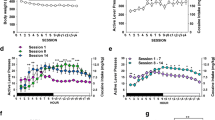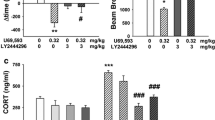Abstract
Rationale
While the effects of several kappa opioid receptor agonists on cocaine-induced reward have been studied, such effects of R-84760, a novel non-peptidic, potent and selective kappa opioid agonist that has been studied in humans, are not yet known.
Objective
To study the effects of R-84760 on basal levels of dopamine, cocaine-induced increases in dopamine levels, cocaine-induced conditioned place preference and locomotor activity in mice.
Methods
In the first experiment, R-84760 was administered i.p. (0, 0.01, 0.05 or 0.1 mg/kg) to C57BL/6J mice. Its effect on basal dopamine levels in the caudate putamen was measured with in vivo microdialysis. In the second experiment, the effect of pretreatment with 0.1 mg/kg R-84760 on cocaine-induced increases in dopamine levels was studied. The third experiment examined the effect of R-84760 (0.1 mg/kg) on the development of cocaine-induced conditioned place preference and locomotor activity in the conditioning chamber.
Results
R-84760 decreased dopamine levels in a dose-dependent manner. The highest dose of R-84760 (0.1 mg/kg, i.p.) significantly decreased dopamine levels relative to vehicle, an effect completely blocked by pre-injection with 10 mg/kg of the kappa-opioid receptor antagonist nor-binaltorphimine (nor-BNI). The same dose of R-84760 blocked cocaine-induced increases in dopamine levels, cocaine-induced conditioned place preference and attenuated cocaine-induced locomotor response.
Conclusion
These findings suggest that R-84760 decreases dopamine levels in the caudate putamen through kappa-opioid receptors. The inhibitory effect of R-84760 on striatal dopamine may contribute to its blockade of cocaine-induced increases in dopamine levels, cocaine-induced conditioned place preference and the associated increases in locomotor activity.





Similar content being viewed by others
References
Acri JB, Thompson AC, Shippenberg TS (2001) Modulation of pre- and postsynaptic dopamine D2 receptor function by the selective kappa-opioid receptor agonist U69593. Synapse 39:343–350
Akimoto K, Hamamura T, Otsuki S (1989) Subchronic cocaine treatment enhances cocaine-induced dopamine efflux, studied by in vivo intracerebral dialysis. Brain Res 495:203
Bals-Kubik R, Herz A, Shippenberg TS (1989) Evidence that the aversive effects of opioid antagonists and kappa-agonists are centrally mediated. Psychopharmacology 98:203–206
Crawford DA, McDougall SA, Bolanos CA, Hall S, Berger SP (1995) The effects of the kappa agonist U-50,488 on cocaine-induced conditioned and unconditioned behaviors and Fos immunoreactivity. Psychopharmacology 120:392–399
Di Chiara G, Imperato A (1988) Drugs abused by humans preferentially increase synaptic dopamine concentrations in the mesolimbic system of freely moving rats. Proc Natl Acad Sci U S A 85:5274–5278
Franklin KBJ, Paxinos G (1997) The mouse brain in stereotaxic coordinates. Academic Press, New York
Fujibayashi K, Sakamoto K, Watanabe M, Iizuka Y (1994) Pharmacological properties of R-84760, a novel kappa-opioid receptor agonist. Eur J Pharmacol 261:133–140
Glick SD, Maisonneuve IM, Raucci J, Archer S (1995) Kappa opioid inhibition of morphine and cocaine self-administration in rats. Brain Res 681:147–152
He M, Shippenberg TS (2000) Strain differences in basal and cocaine-evoked dopamine dynamics in mouse striatum. J Pharmacol Exp Ther 293:121–127
Heidbreder CA, Shippenberg TS (1994) U-69593 prevents cocaine sensitization by normalizing basal accumben dopamine. Neuroreport 5:1797–1800
Heidbreder CA, Goldberg SR, Shippenberg TS (1993) The kappa-opioid receptor agonist U-69593 attenuates cocaine-induced behavioral sensitization in the rat. Brain Res 616:335–338
Institute of Laboratory Animal Resources Commission on Life Sciences, National Research Council (1996) Guide for the care and use of laboratory animals. National Academy of Sciences, Washington, DC
Izenwasser S, Acri JB, Kunko PM, Shippenberg T (1998) Repeated treatment with the selective kappa opioid agonist U-69593 produces a marked depletion of dopamine D2 receptors. Synapse 30:275–283
Kalivas PW, Duffy P (1990) The effect of acute and daily cocaine treatment on extracellular dopamine in the nucleus accumbens. Synapse 5:48–58
Koe BK (1976) Molecular geometry of inhibitors of the uptake of catecholamines and serotonin in synaptosomal preparations of rat brain. J Pharmacol Exp Ther 199:649–661
Kreek MJ, LaForge KS, Butelman E (2002) Pharmacotherapy of addiction. Nat Rev Drug Discov 1:710–726
Kuzmin AV, Semenova S, Gerrits MAFM, Zvartau EE, Van Ree JM (1997) k-Opioid receptor agonist U50,488H modulates cocaine and morphine self-administration in drug-naïve rats and mice. Eur J Pharmacol 321:265–271
Maisonneuve I, Kreek MJ (1994) Acute tolerance to the dopamine response induced a binge pattern of cocaine administration in male rats: an in vivo microdialysis study. J Pharmacol Exp Ther 268:916–921
Maisonneuve IM, Ho A, Kreek MJ (1995) Chronic administration of a cocaine “binge” alters basal extracellular levels in male rats: an in vivo microdialysis study. J Pharmacol Exp Ther 272:652–657
Mello NK, Negus SS (1998) Effects of kappa opioid agonists on cocaine-and food-maintained responding by rhesus monkeys. J Pharmacol Exp Ther 286:812–824
Mori T, Nomura M, Nagase H, Narita M, Suzuki T (2002) Effects of a newly synthesized kappa-opioid receptor agonist, TRK-920 on the discriminative stimulus and rewarding effects of cocaine in rats. Psychopharmacology 161:17–22
Negus SS, Mello NK (2000) Interactions between kappa opioid agonists and cocaine. Ann NY Acad Sci 909:104–132
Negus SS, Mello NK, Portoghese PS, Lin CE (1997) Effects of kappa opioids on cocaine self-administration by rhesus monkeys. J Pharmacol Exp Ther 282:44–55
Reith ME, Li MY, Yan QS (1997) Extracellular dopamine, norepinephrine, and serotonin in the ventral tegmental area and nucleus accumbens of freely moving rats during intracerebral dialysis following systemic administration of cocaine and other uptake blockers. Psychopharmacology 134:309–317
Schenk S, Partridge B, Shippenberg TS (1999) U69593, a kappa-opioid agonist, decreases cocaine self-administration and decreases cocaine-produced drug-seeking. Psychopharmacology 144:339–346
Seymour RA, Stassen L, Moore U, Hawkesford JE, Oshima T, Suggi M, Nimmo WS (2000) A double-blind, placebo-controlled study of the tolerability and efficacy of a new kappa-opioid receptor agonist (R-84760) in patients with pain after dental surgery. Clin Drug Invest 20:409–414
Shippenberg TS, Herz A (1987) Place-preference conditioning reveals the involvement of D1-dopamine receptors in the motivational properties of mu-kappa-opioid agonists. Brain Res 436:169–172
Shippenberg TS, Lefevour A, Heidbreder C (1996) κ-Opioid receptor agonists prevent sensitization to the conditioned rewarding effects of cocaine. J Pharmacol Exp Ther 276:545–554
Smith JD, Loughlin SE, Leslie FM (1992) Kappa-opioid inhibition of [3H] dopamine release from rat ventral mesencephalic dissociated cell cultures. Mol Pharmacol 42:575–583
Spanagel R, Herz A, Shippenberg TS (1990) The effect of opioid peptides on dopamine release in the nucleus accumbens: an in vivo microdialysis study. J Neurochem 55:1734–1740
Suzuki T, Shiozaki Y, Masukawa Y, Misawa M, Nagase H (1992) The role of mu- and kappa-opioid receptors in cocaine-induced conditioned place preference. Jpn J Pharmacol 58:435–442
Thompson AC, Zapata A, Justice JB Jr, Vaughan RA, Sharpe LG, Shippenberg TS (2000) к-Opioid receptor activation modifies dopamine uptake in the nucleus accumbens and opposes the effects of cocaine. J Neurosci 20:9333–9340
Tomohisa M, Mutsuko N, Hiroshi N, Minoru N, Tsutomu S (2002) Effects of a newly synthesized к-opioid receptor agonist, TRK-820, on the discriminative stimulus and rewarding effects of cocaine in rats. Psychopharmacology 161:17–22
Walsh SK, Geter-Douglas B, Strain EC, Bigelow GE (2001) Enadoline and butorphanol: evaluation of к-agonist on cocaine pharmacodynamics and cocaine self-administration in humans. Pharmacology 299:147–158
Wise RA, Newton P, Leeb K, Burnette B, Pocock D, Justice JB Jr (1995) Fluctuations in nucleus accumbens dopamine concentration during intravenous cocaine self-administration in rats. Psychopharmacology 120:10–20
Zhang Y, Schlussman SD, Ho A, Kreek MJ (2001) Effect of acute binge cocaine on levels of extracellular dopamine in the caudate putamen and nucleus accumbens in male C57BL/6J and 129/J mice. Brain Res 923:172–177
Zhang Y, Mantsch JR, Schlussman SD, Ho A, Kreek MJ (2002) Conditioned place preference after single doses or “binge” cocaine in C57BL/6J and 129/J mice. Pharmacol Biochem Behav 73:655–662
Zhang Y, Schlussman SD, Ho A, Kreek MJ (2003a) Effect of chronic “binge” pattern cocaine on levels of extracellular dopamine in the caudate putamen and nucleus accumbens in male C57BL/6J and 129/J mice. Synapse 50:191–199
Zhang Y, Butelman ER, Schlussman SD, Ho A, Kreek MJ (2003b) Effect of the endogenous kappa opioid agonist dynorphin A(1-17) on cocaine-evoked increases in striatal dopamine levels and cocaine-induced place preference in C57BL/6J mice. Psychopharmacology (in press)
Acknowledgements
We thank Susan Russo for her careful reading of the manuscript. This work was supported by National Institutes of Health-National Institute on Drug Abuse Research Center Grant P60-DA05130 and National Institute on Drug Abuse Research Scientist Award K05-DA00049 to Dr. Mary Jeanne Kreek.
Author information
Authors and Affiliations
Corresponding author
Rights and permissions
About this article
Cite this article
Zhang, Y., Butelman, E.R., Schlussman, S.D. et al. Effect of the κ opioid agonist R-84760 on cocaine-induced increases in striatal dopamine levels and cocaine-induced place preference in C57BL/6J mice. Psychopharmacology 173, 146–152 (2004). https://doi.org/10.1007/s00213-003-1716-3
Received:
Accepted:
Published:
Issue Date:
DOI: https://doi.org/10.1007/s00213-003-1716-3




